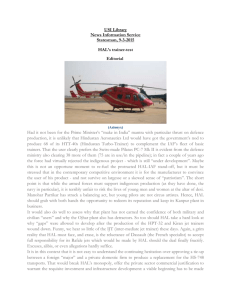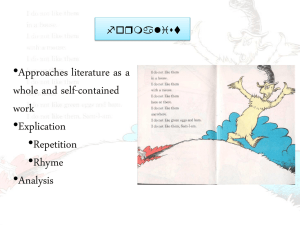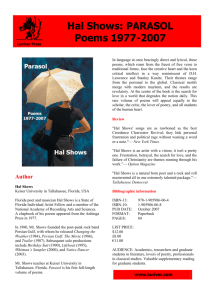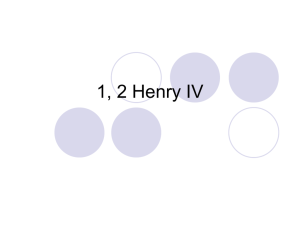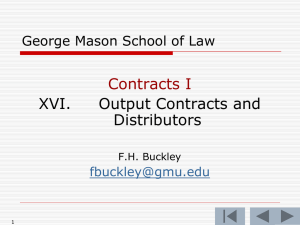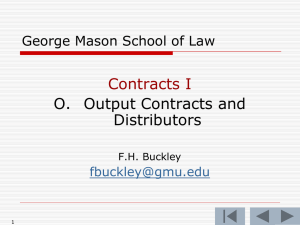Wednesday, Feb. 18
advertisement
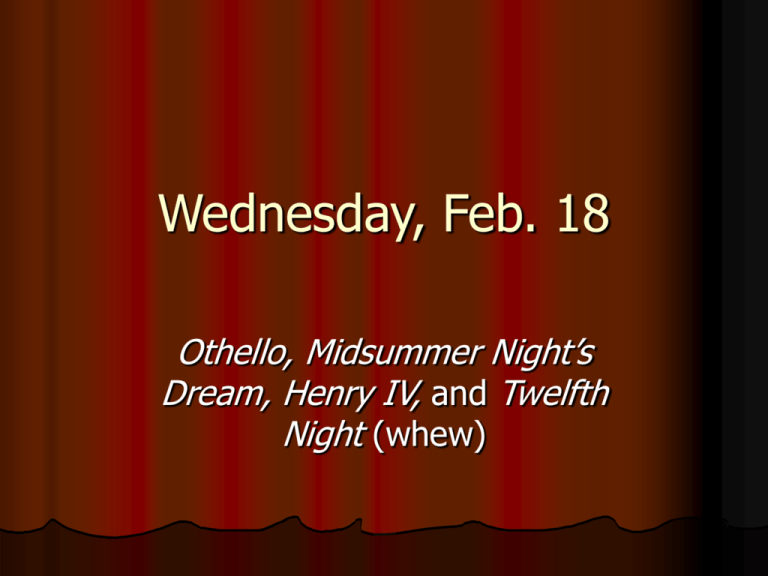
Wednesday, Feb. 18 Othello, Midsummer Night’s Dream, Henry IV, and Twelfth Night (whew) Today Othello acted by Lindsey, Indra, Cynthia, and Iman Quiz on Twelfth Night. Discuss ways in which Twelfth Night is and is not a comedy. The Romance Genre Themes in Twelfth Night? Break Midsummer Night’s Dream acted by Dominique, David, Kimberly, and Jonathan Different critical approaches, as seen in Henry IV Romance Usually the late Shakespearean plays: Winter’s Tale The Tempest Cymbeline Pericles Popular Elizabethan mode, including: Shipwrecks, rediscovery of long lost brothers & sisters, physical marks of recognition, rebirth from the sea Usually a narrative genre, which would give rise to the modern novel Turns on epiphany (“revealing manifestation, sudden flash of insight, or a sudden recognition of identity”) and moments of rebirth Critical Perspectives on Henry IV New Criticism Myth Criticism Psychological Criticism Deconstruction Queer Theory New Historicism Myth Criticism Literature is not just very special words on a page, but is in a continuum with the oldest tribal rituals, and that literature is a cultural practice of our society in which we tell ourselves as a community who we are, partly by telling ourselves what we were. Falstaff harks back to the ancient English fertility rituals in which one person got to be King for the year, and then would be killed at the Winter Solstice to bring fertility in for the new year. In "countries gone waste and barren under the rule of an old, impotent, and guilty king, who must be ritually slain and supplanted by his son or another before the saving rains come, bringing purification and regeneration." The King figures in these rituals were killed and eaten, and then a new one was inaugurated. "Falstaff, in standing for the old king, symbolizes all the accumulated sin of the reign, all the consequent sterility of the land. But the young king draws his knife at the altar and "kills" Falstaff -- by rejecting him in Part 2. According to myth criticism, we see ourselves in the mirror of the play. We see ourselves as Hal who needs to redeem himself, as Hotspur who needs to ask for help and slow down, as Falstaff when we indulge too much. Hal is then a folk hero. New Criticism There is a special concern with metaphor and language, along with emphasis on paradox and irony. A work of art is perfection in itself. Don't look at myths to which the literature is connected or other works written the same year or the author's life, or the historical conditions -- JUST EXAMINE THE TEXT! A. Trace a set of images through a text or B. Look at one passage extremely closely (start with a short passage and examine it) or C. Look for irony and paradox within a text (this will eventually become deconstruction) Take a passage like Hal's early soliloquy and see how that speech is a KEY to the whole play (images used, why he says it, how it connects to other speeches and unifies the play) Unity is important. To a true new critic, every single detail, every character, and every line is a sign of the perfection of the text. You worship it. Look at the connection between the Content and the Form. Deconstruction Deconstructive critics emphasize passages, images, etc. but the assumption is the opposite of New Criticism: that a given text is NOT unified but is a tangled mesh of oppositions, which will reveal themselves to the reader, that a text resists speaking with a single thread (pattern), but instead often has a subversive thread (SUBTEXT) working alongside and unravelling the one which conforms to society. There is almost a contest for power within the text. Hal the darling golden boy and England’s future greatest king vs. Hal the usurper, butcher, conqueror, imperialist Psychoanalytic There are old-style Freudian and post-Freudian readings --emphasis on Characters and settings representing Id, Ego, SuperEgo --Return of the Repressed --Oedipus complexes (Electra complexes) --childhood trauma, usually before 6, sometimes adolescence "Prince Hal's struggle against his father appears in isolation (no sleeping with mother), enacted in male society. The defense which Prince Hal mobilizes in order to escape from his internal predicament are well known from the clinical studies of male youths, who see a faulty father figure, and therefore mirror back to the king the King's moral depravity. Hal mirrors back the King's depravity to him, and also acquires a substitute antithesis of Father in Falstaff. Then the Prince triumphs over both the Father and the Father substitute Queer Theory More radical views hint at Oedipal stuff with Falstaff as Queen. New Historicism This is like old historical approaches and a rebellion against all 4 previous, especially new criticism and deconstruction. New H's say that you cannot understand a text unless you understand it within its specific historical context. Further, you understand the text as playing an active role in the life of a culture. Marxist version: the text arises (basically authorless) out of the social conditions. New Historicism is more dialectical and sees interplay between text and culture, culture and text
